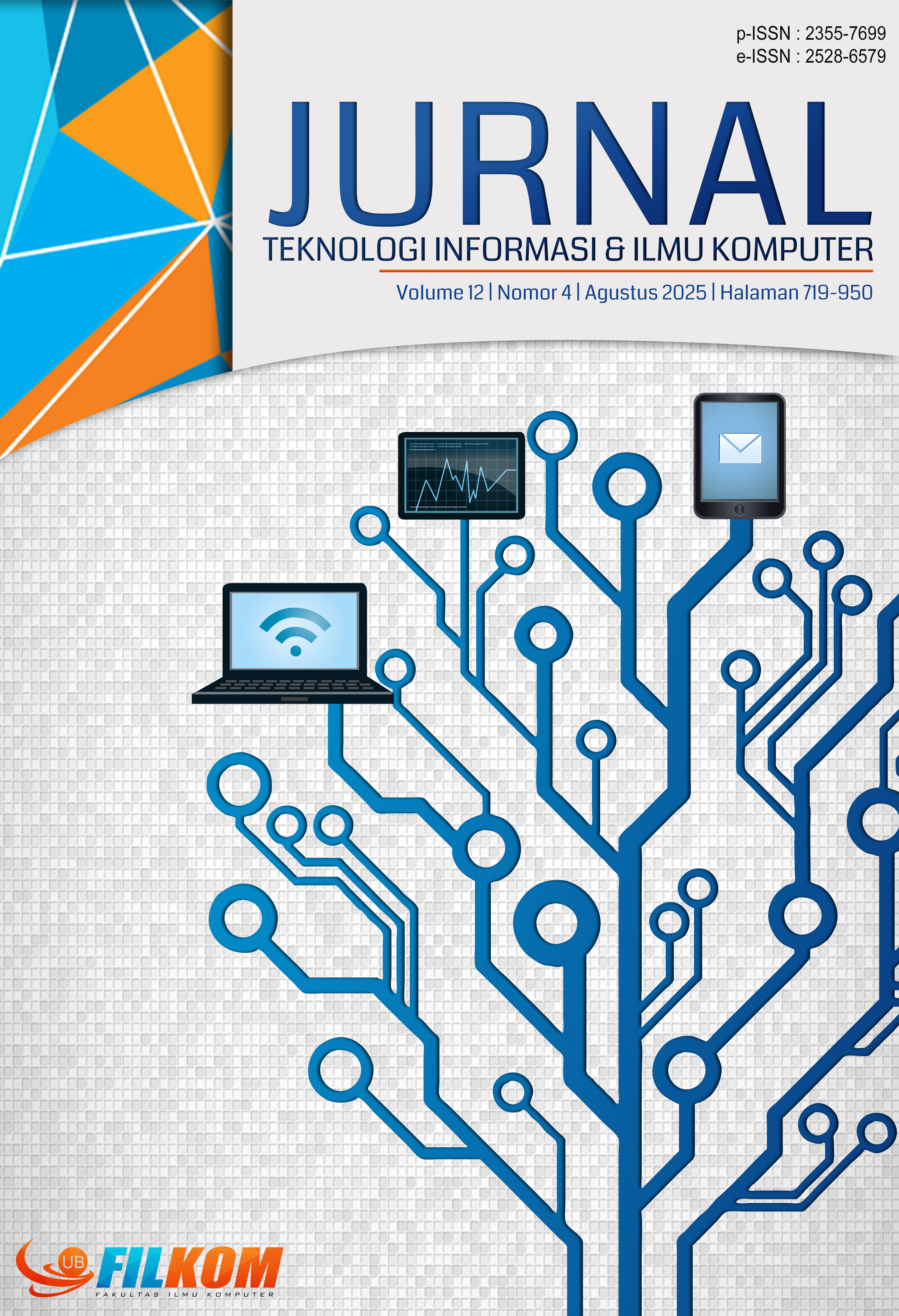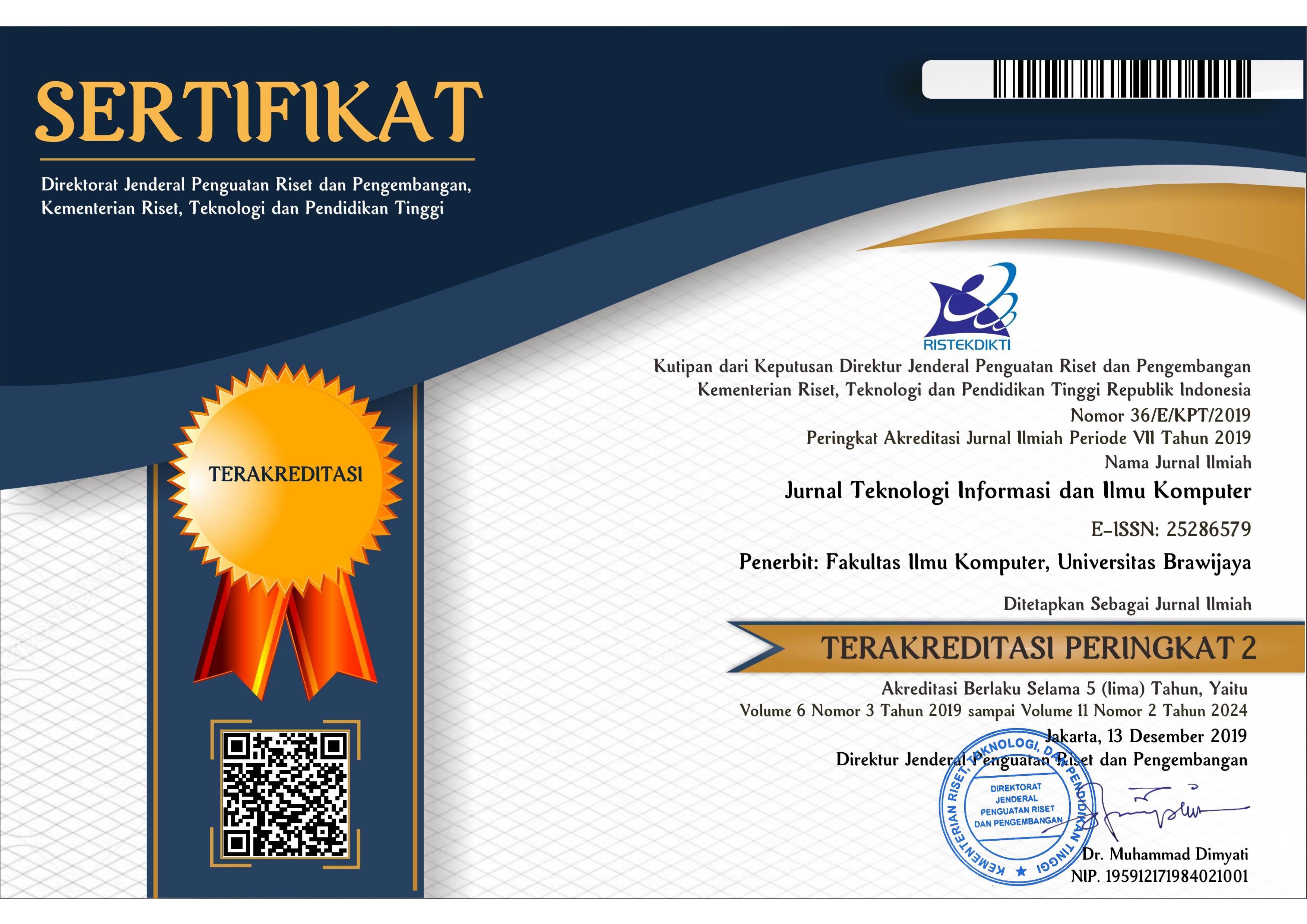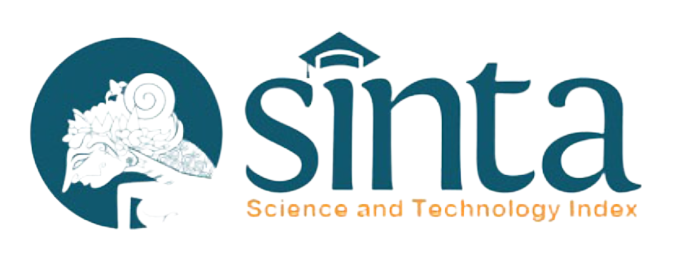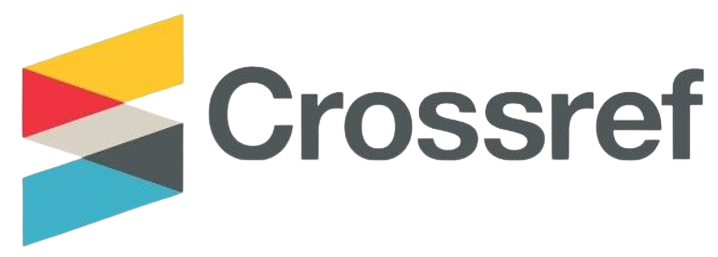Pengembangan Model Multilayer Classifier Menggunakan Metode Ensemble Learning untuk Grading Brokoli
DOI:
https://doi.org/10.25126/jtiik.124Kata Kunci:
Grading, Convolution Neural Network, Ensemble Learning, VotingAbstrak
Permintaan brokoli di Indonesia terus meningkat 15% sampai dengan 20% per tahun. Sayangnya supply masih terbatas dan kualitas masih kurang. Untuk menentukan kualitas brokoli diperlukan adanya proses grading yaitu proses pemeringkat brokoli menjadi grade A, B dan C berdasarkan tiga parameter utama yaitu warna, ukuran, dan bentuk. Sayangnya, tidak semua petani memahami mengenai proses grading tersebut. Hal ini menyebabkan kerugian pada petani dan pengusaha brokoli. Penelitian ini bertujuan untuk mengembangkan algoritma grading menggunakan Convolusional neural network (CNN) berdasarkan 2 buah citra yaitu citra kepala brokoli dari tampak atas dan tampak samping. Dataset pada penelitian ini sebesar 600 data. Teknik yang digunakan ialah modifikasi beberapa model deep learning yaitu ResNet50, EfficientNetB2, VGG16 pada bagian layer klasifikasinya, lalu dibandingkan dengan hasil akurasi dari masing-masing outputnya. Penelitian ini juga menggunakan metode ensemble learning dimana menggunakan kombinasi dari 3 fitur berbeda. Fitur warna, ukuran dan bentuk digabungkan pada proses training dan testing untuk melakukan klasifikasi grade brokoli. Pada fase testing digunakan teknik voting untuk pengambilan keputusan grading. Akurasi terbaik ada pada model ResNet50 dengan hasil klasifikasi brokoli sebesar 90% yang didapatkan melalui penggunaan 5 dense layer pada layer klasifikasi, sehingga mampu melebihi hasil akurasi dari beberapa model deep learning lainnya. Algoritma dari penelitian ini menawarkan solusi grading yang lebih objektif dan konsisten dibandingkan sistem manual, sehingga petani dan pengusaha brokoli dalam meningkatkan efisiensi, mengurangi kerugian, dan memastikan kualitas produk yang lebih baik bagi konsumen.
Abstract
The demand for broccoli in Indonesia has been increasing by 15% to 20% annually. However, supply remains limited, and quality control is inadequate. To assess broccoli quality, a grading process is required, classifying broccoli into Grades A, B, and C based on three primary parameters: color, size, and shape. Unfortunately, not all farmers possess sufficient knowledge of this grading process, leading to financial losses for both farmers and broccoli businesses. This study aims to develop a grading algorithm using a Convolutional Neural Network (CNN) based on two images, namely a top-view and a side-view image of a broccoli head. The dataset comprises 600 samples. The methodology involves modifying the classification layers of several deep learning models, namely ResNet50, EfficientNetB2, and VGG16, and comparing their classification accuracy. Additionally, an ensemble learning approach is employed, integrating three distinct features—color, size, and shape—into the training and testing phases for broccoli grading. The voting technique is utilized in the testing phase to enhance decision-making in the grading process. Experimental results indicate that the ResNet50 model achieves the highest classification accuracy at 90%, attributed to the incorporation of five dense layers in the classification stage. This performance surpasses that of other deep learning models. The proposed algorithm provides a more objective and consistent grading system compared to manual methods, enabling farmers and broccoli enterprises to enhance efficiency, reduce financial losses, and ensure higher product quality for consumers.
Downloads
Referensi
ALOMAR, K., AYSEL, H.I. & CAI, X., 2023. Data Augmentation in classification and segmentation: A survey and new strategies. Journal of Imaging, 9(2), p.46.
BLOK, P.M., VAN EVERT, F.K., TIELEN, A.P.M., VAN HENTEN, E.J. & KOOSTRA, G., 2021. The effect of data augmentation and Network simplification on the image-based detection of broccoli heads with Mask R-CNN. Journal of Field Robotics, 38(1), pp.85–104.
CIREŞAN, D., MEIER, U. & SCHMIDHUBER, J., 2012. Multi-column Deep Neural Networks for Image Classification. [online] Available at: <http://arxiv.org/abs/1202.2745>.
DELL’AQUILA, A., 2009. Digital imaging information technology applied to seed germination testing. A review. Agronomy for Sustainable Development, 29 (1), p.213-221
GRANDINI, M., BAGLI, E. & VISANI, G., 2020 ‘Metrics for Multi-Class Classification: an Overview’, pp. 1–17. Available at: http://arxiv.org/abs/2008.05756.
GUO, L., WANG, P., GU, Z., JIN, X. & YANG, R., 2017. Proteomic analysis of broccoli sprouts by iTRAQ in response to jasmonic acid. Journal of Plant Physiology, 218, pp.16–25.
HELEN JOSEPHINE, V.L., NIRMALA, A.P. , ALLURI, V.L., 2021. Impact of Hidden Dense layers in Convolutional Neural Network to enhance Performance of Classification Model. IOP Conference Series: Materials Science and Engineering, 1131(1), p.012007.
ISMAIL, N. & MALIK, O.A., 2022. Real-time visual inspection system for grading fruits using computer vision and deep learning techniques. Information Processing in Agriculture, [online] 9(1), pp.24–37.
KRIZHEVSKY, A. & HINTON, G.E., 2017. ImageNet Classification with Deep Convolutional Neural Networks, 60(6), p.84-90.
KUMAR, V., SINGH AYDAV, P.S. & MINZ, S., 2022. Multi-view Ensemble Learning using multi-objective particle swarm optimization for high dimensional data classification. Journal of King Saud University - Computer and Information Sciences, 34(10), pp.8523–8537. Min. Knowledge Discov. 8 (4), e1249.
KUSUMAM, K., KRAJNÍK, T., PEARSON, S., CIELNIAK, G. DUCKETT, T., 2016. Can you pick a broccoli? 3D-vision based detection and localisation of broccoli heads in the field. In: IEEE International Conference on Intelligent Robots and Systems. Institute of Electrical and Electronics Engineers Inc. https://doi.org/doi:10.1109/IROS.2016.7759121 pp.646–651.
PUJI ASTUTIK, M. & RESPATIJARTI, 2019. Uji Daya Hasil Beberapa Genotipe Brokoli (Brassica oleracea var. italica L.) di Dataran Tinggi Potential Yeild Trial Several Genotype of Broccoli (Brassica oleracea var. italica L.) in The Highlands. Jurnal Produksi Tanaman, 7(3), pp.480–487.
RAMIREZ, R.A., 2006. Computer Vision Based Analysis of Broccoli for Application in a Selective Autonomous Harvester. Master of Science Thesis. Virginia Polytechnic Institute and State University
SAGI, O., ROKACH, L., 2018. Ensemble Learning: A survey. Wiley Interdiscip. Rev.: Data, 8, 10.1002/widm.1249
SHORTEN, C. and KHOSHGOFTAAR, T.M., 2019. A survey on image data augmentation for Deep learning. Journal of Big Data, 6(1).
THARWAT, A., 2020. Classification assessment methods. Applied Computing and Informatics, 17(1), pp.168–192.
ZHOU, C., HU, J., XU, Z., YUE, J., YE, H. & YANG, G., 2020. A monitoring system for the segmentation and grading of Broccoli head based on Deep learning and Neural Networks. Frontiers in Plant Science, 11, p.402
Unduhan
Diterbitkan
Terbitan
Bagian
Lisensi
Hak Cipta (c) 2025 Jurnal Teknologi Informasi dan Ilmu Komputer

Artikel ini berlisensiCreative Commons Attribution-ShareAlike 4.0 International License.

Artikel ini berlisensi Creative Common Attribution-ShareAlike 4.0 International (CC BY-SA 4.0)
Penulis yang menerbitkan di jurnal ini menyetujui ketentuan berikut:
- Penulis menyimpan hak cipta dan memberikan jurnal hak penerbitan pertama naskah secara simultan dengan lisensi di bawah Creative Common Attribution-ShareAlike 4.0 International (CC BY-SA 4.0) yang mengizinkan orang lain untuk berbagi pekerjaan dengan sebuah pernyataan kepenulisan pekerjaan dan penerbitan awal di jurnal ini.
- Penulis bisa memasukkan ke dalam penyusunan kontraktual tambahan terpisah untuk distribusi non ekslusif versi kaya terbitan jurnal (contoh: mempostingnya ke repositori institusional atau menerbitkannya dalam sebuah buku), dengan pengakuan penerbitan awalnya di jurnal ini.
- Penulis diizinkan dan didorong untuk mem-posting karya mereka online (contoh: di repositori institusional atau di website mereka) sebelum dan selama proses penyerahan, karena dapat mengarahkan ke pertukaran produktif, seperti halnya sitiran yang lebih awal dan lebih hebat dari karya yang diterbitkan. (Lihat Efek Akses Terbuka).















